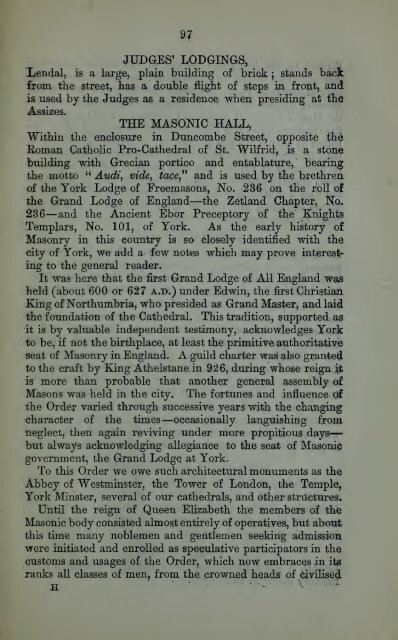practicalguideto00unse_0
Create successful ePaper yourself
Turn your PDF publications into a flip-book with our unique Google optimized e-Paper software.
97<br />
JUDGES' LODGINGS,<br />
Xendal, is a large, plain building of brick ; stands back<br />
from the street, has a double flight of steps in front, and<br />
is used by the Judges as a residence when presiding at the<br />
:^k.ssizes<br />
THE MASONIC HALL,<br />
Within the enclosure in Duncombe Street, opposite the<br />
Eoman Catholic Pro- Cathedral of St. Wilfrid, is a stone<br />
building with Grecian portico and entablature, bearing<br />
the motto Audi^ vide^ tace^'' and is used by the brethren<br />
of the York Lodge of Freemasons, No. 236 on the roll of<br />
the Grand Lodge of England-—the Zetland Chapter, No.<br />
236— and the Ancient Ebor Preceptory of the Knights<br />
Templars, No. 101, of York. As the early history of<br />
Masonry in this country is so closely identified with the<br />
city of York, we add a few notes which may prove interesting<br />
to the general reader.<br />
It was here that the first Grand Lodge of All England was<br />
held (about 600 or 627 a.d.) under Edwin, the first Christian<br />
King of Northumbria, who presided as Grand Master, and laid<br />
the foundation of the Cathedral. This tradition, supported as<br />
it is by valuable independent testimony, acknowledges York<br />
to be, if not the birthplace, at least the primitive authoritative<br />
seat of Masonry in England. A guild charter was also g:^anted<br />
to the craft by King Athelstane in 926, during whose reign it<br />
is more than probable that another general assembly of<br />
Masons was held in the city. The fortunes and influence of<br />
the Order varied through successive years with the cha^nging<br />
character of the times—occasionally languishing from<br />
neglect, then again reviving under more propitious days---<br />
but always acknowledging allegiance to the seat of Masonic<br />
government, the Grand Lodge at York,<br />
To this Order we owe such architectural monuments as the<br />
Abbey of Westminster, the Tower of London, the Temple,<br />
York Minster, several of our cathedrals, and other structures.<br />
Until the reign of Queen Elizabeth the members of the<br />
Masonic body consisted almost entirely of operatives, but about<br />
this time many noblemen and gentlemen seeking admission<br />
were initiated and enrolled as speculative participators in the<br />
customs and usages of the Order, which now embraces in its<br />
jranks all classes of men, from the crowned heads of civilised















